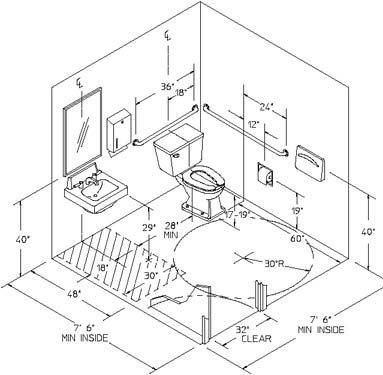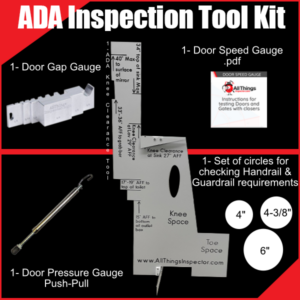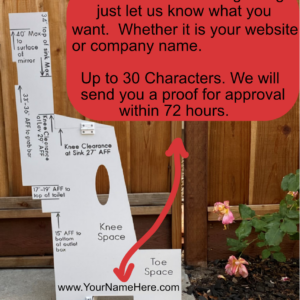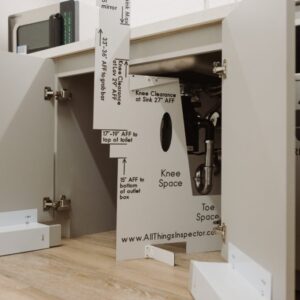ADA Bathroom Requirements 2023
with the ADA Inspection Tool Kit
The ADA Inspection Tool Kit will save you Time and Money.
It was designed mainly for checking ADA Bathroom Requirements for the busy ADA Compliance Professional. Get yours today.
Calling All Busy ADA Compliance Professionals: Upgrade to our ADA Inspection Tool Kit to help you check your ADA Bathroom Requirements Today! Are you a master builder, visionary architect, certified CASP, meticulous inspector or simply a passionate advocate for ADA Compliance? Whether you’ve been contracted to ensure ADA Bathroom Requirements or conduct an extensive ADA accessibility survey for a towering eleven-story government building or a sprawling five hundred-room apartment complex, we understand the time-consuming nature of ADA Inspections.
But worry not, for we have the ultimate solution: Introducing our exclusive selection of ADA Knee Clearance templates, designed specifically for those who crave efficiency without compromising on quality. Say goodbye to excessive bells and whistles and say hello to a streamlined and hassle-free ADA Inspection kit. By upgrading your bathroom requirements toolkit today, you’ll benefit from a wealth of innovative features that will revolutionize your ADA Compliance journey.
Prepare to be amazed as our enhanced templates guide you through each step with ease and precision, ensuring absolute compliance while saving you valuable time. So, what are you waiting for? Don’t let the intricacies of ADA bathroom requirements bog you down any longer. Join our community of dedicated professionals who are committed to delivering seamless accessibility for all.
Upgrade to our cutting-edge ADA Knee Clearance templates and embark on a new era of efficiency today! Remember, when it comes to ADA Compliance, every detail matters. Trust in our superior tools to help you create accessible spaces that go above and beyond expectations. Don’t settle for standard – choose excellence. Get your hands on our game-changing ADA Inspection Kit now!
What if my business tax exempt?
Uncover ADA Compliance in Seconds: Upgrade Your Inspections with Our Top-Rated ADA Inspection Tool Kit to quickly check ADA Restroom Requirements.




Some of Our Previous Clients Include





FAQ
Frequently Asked Questions
When it comes to ADA Bathroom Requirements, there is no shortage of information. The most frequently asked question about ADA Bathroom Requirements has been answered by our team and we’ve provided you with some other relevant questions that often come up!
ADA Requirements for Public Restrooms
ADA (Americans with Disabilities Act) Bathroom requirements are crucial for ensuring equal access and independence for individuals with disabilities. These requirements are specifically designed to address the needs of people with physical disabilities, allowing them to use public restrooms with ease and dignity. By mandating accessible design features, the ADA ensures that all individuals, regardless of their mobility limitations, can enjoy public spaces and facilities without hindrances.
One of the primary reasons why ADA Bathroom requirements are crucial is their impact on inclusivity. Accessible bathrooms eliminate barriers for people with disabilities, enabling them to navigate public areas independently. These requirements stipulate various features, such as wider entrance doors, accessible stalls, grab bars, accessible sinks, and clear floor spaces. By incorporating these accommodations, public ADA restrooms become accessible to wheelchair users, individuals with walkers, and those with limited mobility. This helps promote a sense of inclusivity and equal opportunity for participation in public life.
Moreover, ADA Bathroom requirements also enhance safety for people with disabilities. For individuals who rely on mobility aids, such as wheelchairs, accessibility features like grab bars and appropriate stall dimensions provide necessary stability and support. These features prevent accidents, falls, and injuries, ensuring the well-being of individuals with disabilities. Additionally, accessible restrooms equipped with emergency call systems or properly marked exit signage aid in emergency situations and evacuation procedures, promoting a safer environment for everyone.
Beyond inclusivity and safety, ADA Bathroom requirements also have legal implications. The ADA mandates that all public accommodations, including restrooms, be accessible to individuals with disabilities. Failure to comply with these regulations can result in legal action, penalties, or fines. By adhering to ADA requirements, businesses and public spaces not only avoid legal consequences but also demonstrate their commitment to providing equal opportunities and accessible facilities for all individuals.
In conclusion, ADA Bathroom requirements play a crucial role in ensuring equal access and dignity for individuals with disabilities. By incorporating accessible bathroom design features, public restrooms become inclusive, safe, and legally compliant. These requirements empower people with disabilities to navigate public spaces with independence, fostering a more inclusive society. It is essential for individuals, businesses, and organizations to recognize the significance of ADA Bathroom requirements and advocate for accessible design to cater to the diverse needs of all individuals.
Knee and Toe Clearance:
ADA compliant bathrooms should provide adequate ADA knee clearance beneath sinks and countertops. The space beneath these elements should be free of obstructions to accommodate individuals using wheelchairs. The ADA specifies the required dimensions for knee space in bathrooms and toe clearance to ensure accessibility.
Toilet Height:
ADA Toilet requirement - Toilets in ADA compliant bathrooms should be between 17 and 19 inches in height measured from the floor to the top of the toilet seat. This height is designed to facilitate easier transfers for individuals with mobility challenges.
Grab Bars:
Grab bars are essential in ADA compliant bathrooms and should be installed near toilets and along the walls of the shower or bathtub. The ADA specifies the height, length, and location of these ADA grab bars to provide support and stability for individuals with disabilities.
Sink and Countertop Height:
The ADA requires that sinks and countertops be at a maximum ADA sink height of 34 inches, with knee clearance beneath to accommodate individuals using wheelchairs. This allows for easier access and use of the sink area.
Accessible Mirrors:
Mirrors in ADA-compliant bathrooms should be mounted with the bottom edge of the reflecting surface no higher than 40 inches above the floor. This ensures that individuals using wheelchairs or of shorter stature can comfortably use the mirror.
ADA Bathroom Requirements are important because they tell businesses and people how bathrooms should be designed for example to allow a person in a wheelchair or mobility scooter for example; to pull their wheelchair under the counter to wash their hands or get a drink at a drinking fountain.
With our ADA Knee Clearance Template you can quickly and accurately check ADA knee clearance and other ADA bathroom requirements. Learn more about the ADA Knee Space Template. On the rim or counter surface, it will be tough to work on the finish floor or ground space. That is why it is essential to take this matter seriously.
You will also have to measure the height of the toilets and this template can assist you with that as well. Again, no need for a tape measure, imagine how much faster your inspections can go. In order to measure the knee and toe clearance just slide the template right under the ADA sink and you can quickly see if you meet the knee space under counter.
However, it is hard to work on the finished floor or ground space. Also, sharp or abrasive surfaces always provide wrong measurements. So, when you consider knee and toe clearance, you need to ensure the right toolkit that measures it properly.
These measurements will be for kitchen sinks, restrooms, and drinking fountains. When the building is a large commercial building it can be quite a challenge to measure all of the various areas that need to be inspected. Imagine the time saved but also no need to try to remember every tolerance with this handy tool.
While there are ADA knee and toe clearances there are also other things this tool can assist with as well. Looking at the grab bars, for example, is another as well as it will test to ensure the well mounted mirror is within tolerances as well. The mirror has to be low enough that the person can see themselves in the full lenght mirror. Because of this, there is a tolerance for this as well. For an ADA compliant toilet compartment, there should have to be maximum depth for a towel dispenser, toilet paper dispenser, water supply, soap dispenser, and hand dryer, which need to ensure required knee and toe clearance. Keeping additional clearance according to building codes is always a better option. And having bottom edge clear floor space for extending greater need.
Drinking Fountain ADA Clearance is similar to bathroom ADA clearances in which someone that is seated should be able to use the facility. This is also the case in Bathroom ADA Clearances.
There should be a deep minimum available knee clearance that can be easier for wheelchair entry. It should be a conventional range and a wide minimum to provide forward reach.
While many of us go through life not knowing all that needs to go into building a commercial building. Inspectors know what to look for and understand the labor it takes to fully inspect these sorts of areas. However, these inspections can be very time-consuming, which is why All Things Inspector came up with this original design.
It is important for contractors, inspectors, and architects to pay close attention to ADA knee space requirements when in the design and construction phase of new building projects. It is estimated that there are 2.7 million wheelchair users in the united states.
Check out our new line of ADA templates for expediting ADA inspections.
We all know that persons in wheelchairs have limited mobility and reach and it makes it harder for them to access everyday fixtures like sinks and drinking fountains. That is why we have rules and regulations governing ADA Clearance requirements such as the 2010 ADA Standards which set minimum standards for accessible design.
Also very important to people in wheelchairs is proper door opening forces. You may want to check out our door pressure gauges so you can check door opening forces as part of your ADA inspections.
ADA Lavatory clearance should be measured for the minimum knee clearance and must be free of equipment or obstructions for a minimum of 8 inches (205 mm) extending from the front edge of the lavatory back toward the wall. This knee clearance must be 29 inches (735 mm) high at the front of the lavatory and no less than 27 inches (685 mm) high at a point 8 inches (205 mm) back. In addition, a minimum 9 inches (230 mm) high toe clearance must be provided extending back toward the wall to a distance no more than 6 inches (150 mm) from the back wall. The toe clearance space must be free of equipment or obstructions. To ensure an accessible lavatory, you have to make the toilet room according to the lavatory clearances of ADA compliance.
The maximum height of the lavatory is 34 inches (865 mm).
Assess Your Current Bathroom:
Evaluate ADA Bathroom Layout and Design: Measure clear floor spaces and maneuvering areas, ensuring they meet ADA requirements. Consider door widths to guarantee accessibility for individuals with disabilities.
Inspect Fixtures and Bathroom Accessories: Assess the heights of the toilet sink and bathroom partition to ensure they comply with ADA compliant restroom standards. Check for proper grab bar installation, as these are crucial for providing support and stability.
Identify Areas that Need improvement:
Utilize an ADA Compliance Checklist: Employ a checklist to identify non-compliant elements in your bathroom systematically. This checklist should cover crucial aspects such as clear spaces, doorways, and fixture heights.
Seek User Feedback: Gather insights from individuals with disabilities to understand specific challenges they may face. This firsthand feedback is invaluable in identifying areas that may not align with the needs of users.
Make the Necessary Modifications:
Prioritize Modifications: Address critical areas first, focusing on elements that significantly impact accessibility. This could include adjusting fixture heights, widening doorways, or installing additional grab bars.
Engage Professionals: For more complex modifications, such as structural changes or installations, consult with professionals experienced in ADA compliance. This ensures that the modifications meet regulatory standards and provide maximum accessibility.
How many ADA bathroom requirements can you spot in the image below?

Below is a quick list of 11 ADA Bathroom Requirements.
- Clear Floor Space: There must be a clear floor space in front of fixtures, such as toilets and sinks, to allow for wheelchair maneuverability.
- Grab Bars: Grab bars are often required around toilets and in showers to provide support and stability for individuals with mobility impairments.
- Toilet Height: Toilet seats in ADA-compliant bathrooms are typically between 17 and 19 inches above the finished floor to accommodate individuals with mobility challenges.
- Sink Height: Accessible sinks should have a clear space underneath, and their height should be suitable for wheelchair users.
- Mirror Height: Mirrors should be mounted at a height that is usable by individuals in wheelchairs.
- Clear Turning Space: There should be adequate space within the bathroom for a disabled person who is using a wheelchair to turn around.
- Accessible Dispensers: Soap dispensers, paper towel dispensers, and other amenities like flush controls, and water closets should be at a height that is accessible to individuals with disabilities.
- Signage: Proper signage indicating the location of accessible facilities is essential.
- Door Clearance: Doors to accessible bathrooms should provide enough clearance for a wheelchair user to enter and maneuver.
- Toe Clearance: Sinks and other fixtures should provide adequate toe clearance for wheelchair users.
- Accessible Mirrors: Mirrors should be mounted with the bottom edge of the reflecting surface no higher than 40 inches above the finished floor.
Common Mistakes and How to Avoid Them
Failure to Understand Requirements: Take the time to thoroughly understand and stay updated on the ADA guidelines, including specific requirements for your facility. This includes areas such as parking, entrances, and restrooms.
Regular Training and Updates: Keep staff well-informed about ADA requirements through regular training sessions. This helps prevent oversights and ensures everyone is aware of their role in maintaining ADA compliance bathroom.
Insufficient Clear Floor Spaces: Prioritize clear floor spaces to accommodate individuals with mobility devices, ensuring they can navigate freely. Regularly assess layouts to maintain proper spacing.
Consideration for Flow: Avoid overcrowded layouts that impede the flow of movement. Adequate planning ensures a comfortable and accessible environment for all.
Integration of Technology: Embrace technological advancements to enhance accessibility, such as voice-activated controls, sensor-based faucets, and other smart solutions. Integrate these technologies thoughtfully into your facilities.
Contact Us For More Updates
By prioritizing ADA compliancy, businesses contribute to a more inclusive society where everyone, regardless of ability, can participate fully in public life. For further assistance or inquiries on meeting ADA bathroom requirements at your business, call us at 1-559-309-5231 or Email us at: [email protected]




